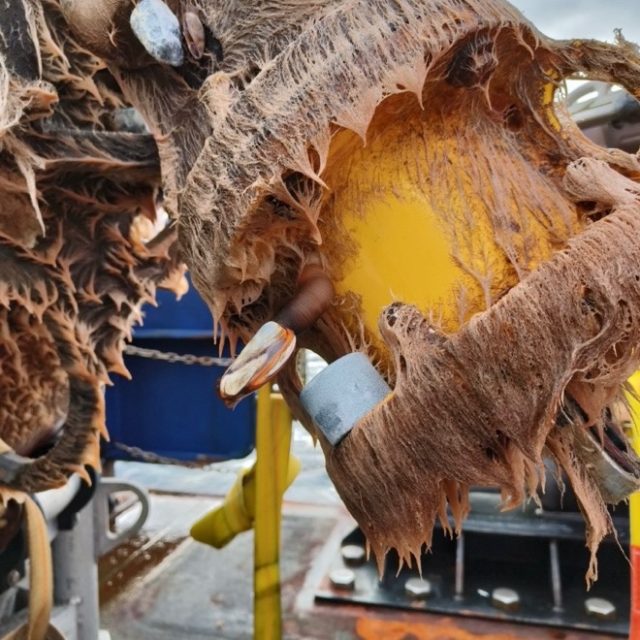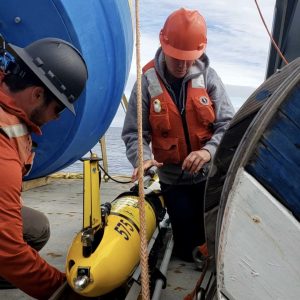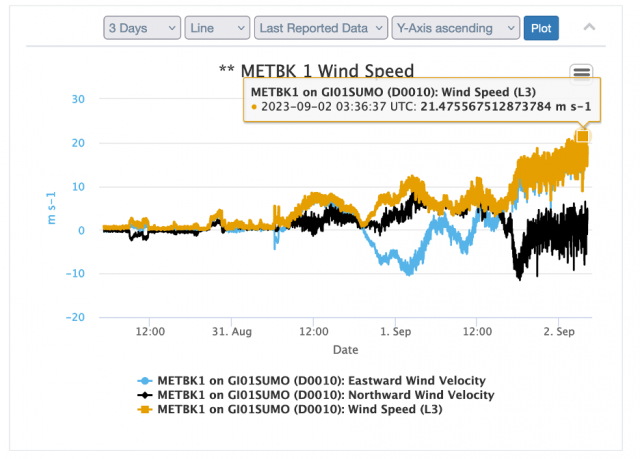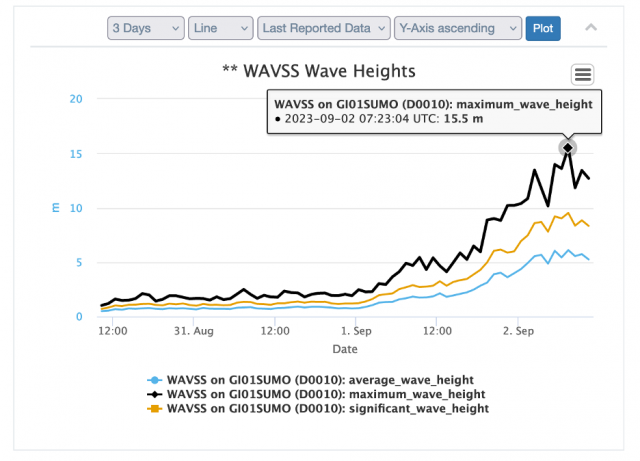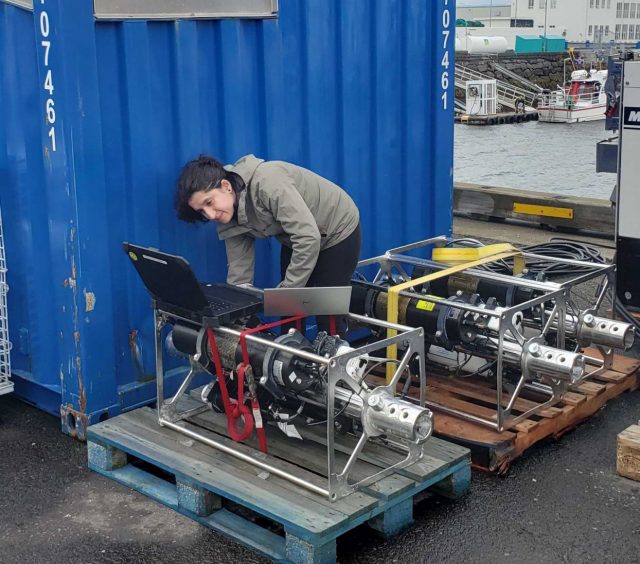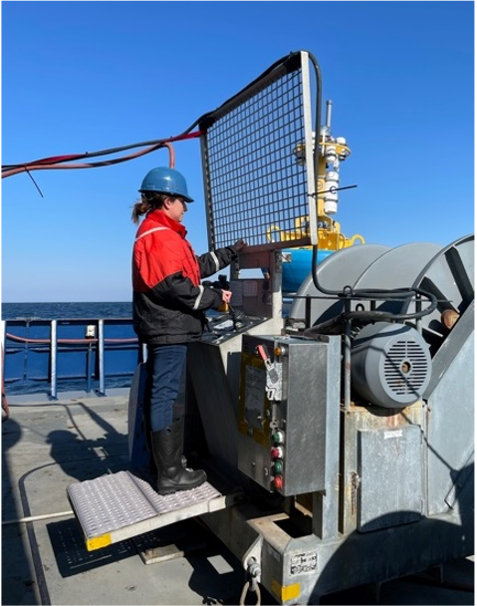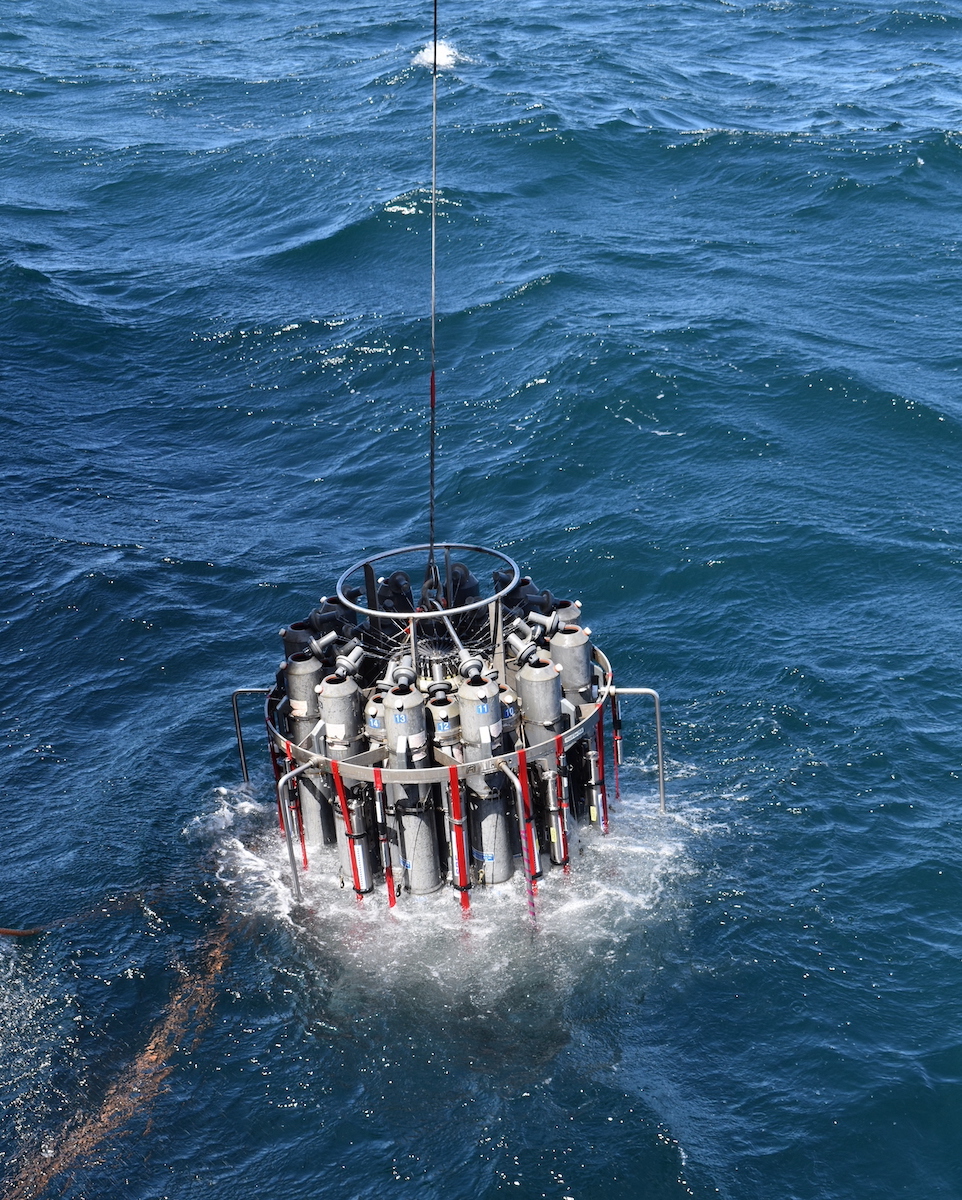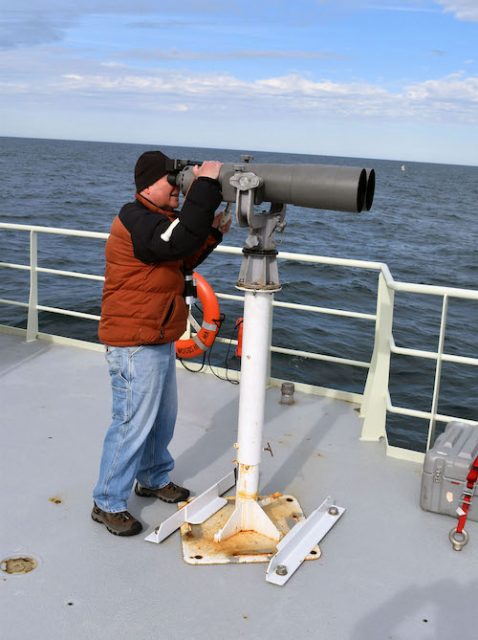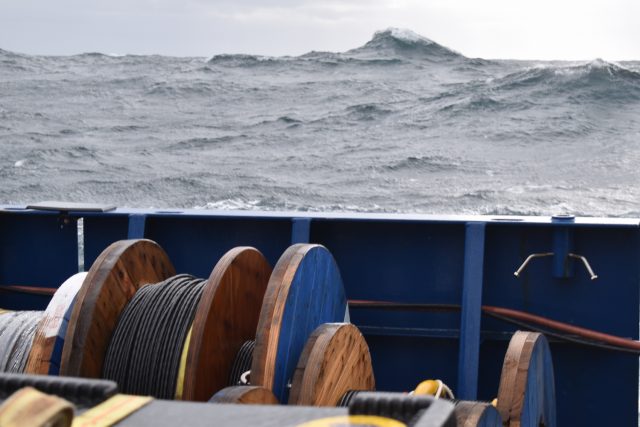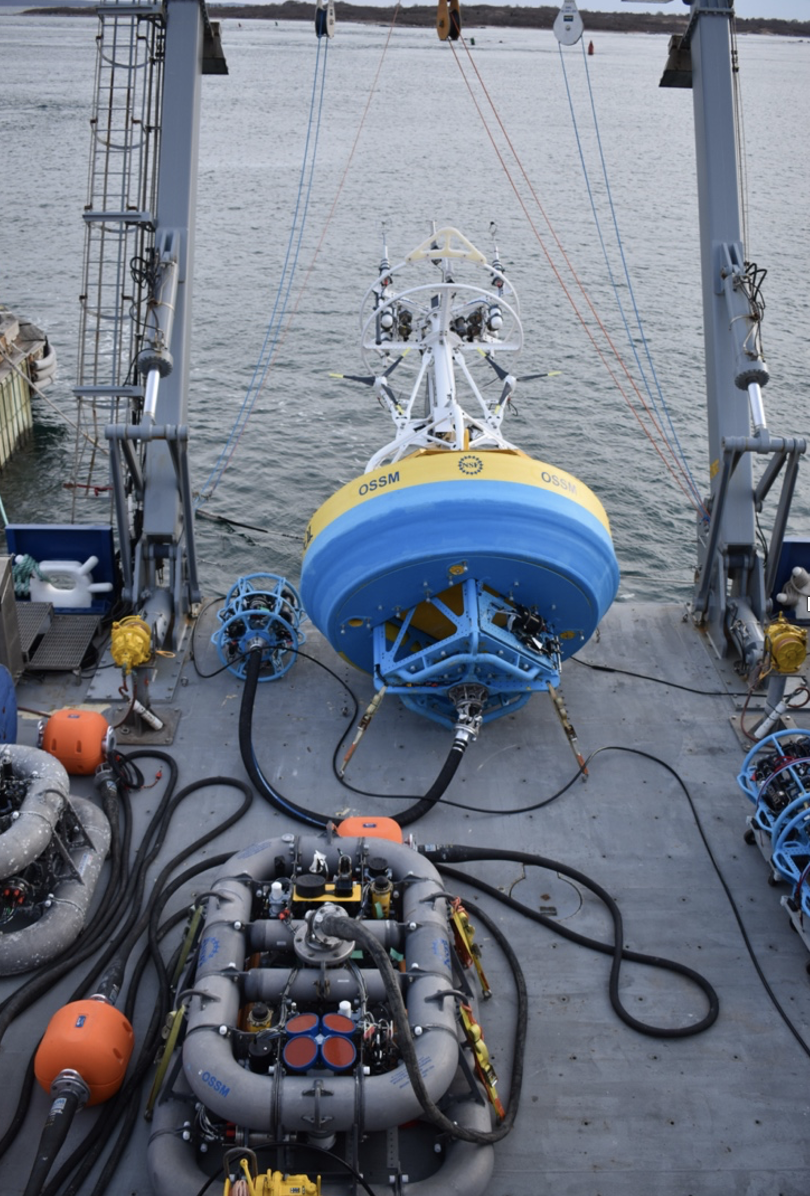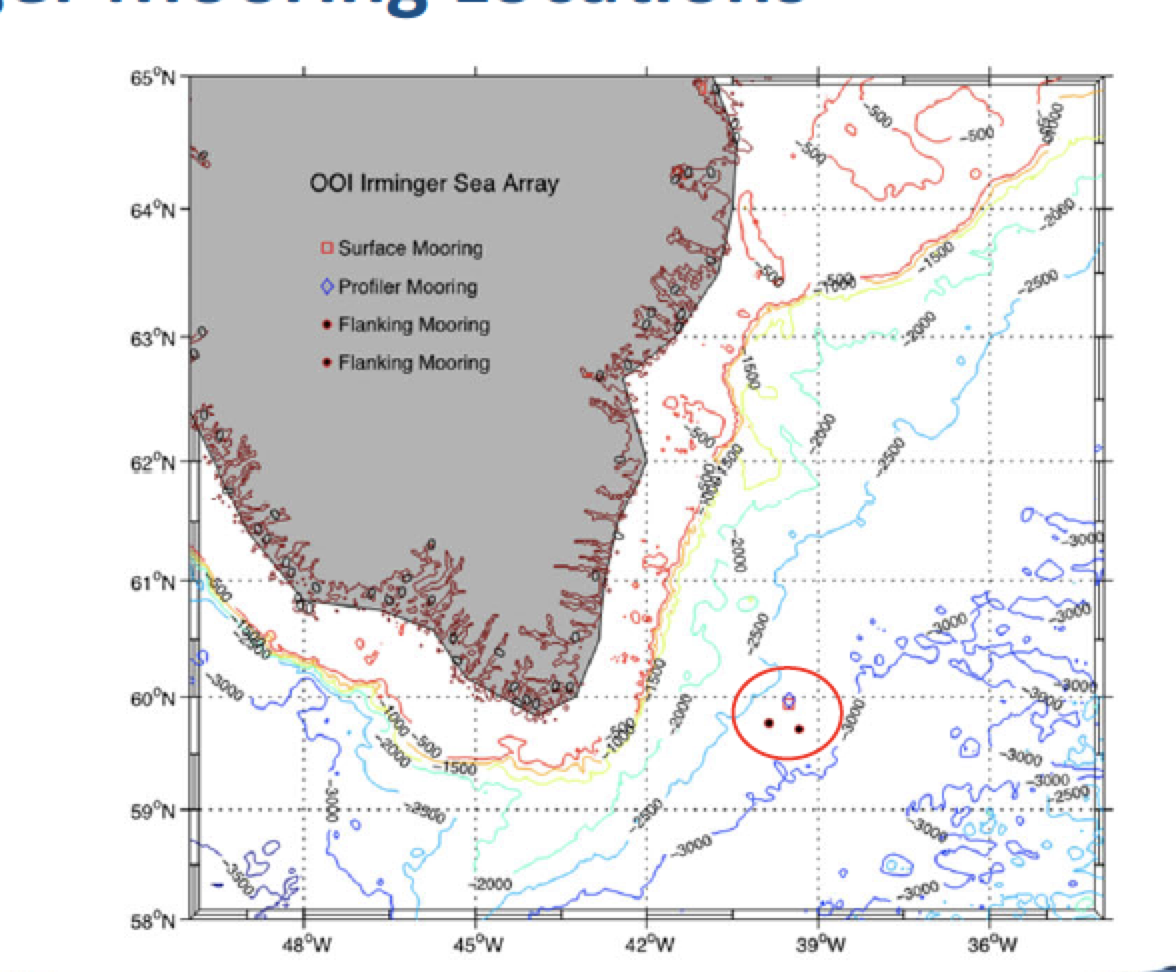Posts Tagged ‘Global Irminger Sea’
Global Station Papa Expedition Succeeds Despite Weather
And what a wild ride it was! The US National Science Foundation Ocean Observatories Initiative (OOI) 11th expedition to the Global Station Papa Array aboard the R/V Sikuliaq had a bit of trouble with the weather gods during its 17-day journey in the Gulf of Alaska. For safety reasons because the ship cannot deploy large moorings in conditions with ~20’ seas and high winds, the ship spent almost five of the 17-days moving in and out of the array site, trying to find “safer ground” to wait out the worst of the storms.
Nonetheless, the Coastal and Global Scale Nodes team (CGSN) based at Woods Hole Oceanographic Institution (WHOI) and a Waverider mooring team from the University of Washington succeeded in meeting all their mission objectives. Despite the extra transit and down days, the teams recovered and deployed three OOI subsurface moorings and two open ocean gliders. They recovered and deployed a Waverider mooring for the University of Washington. A POGO Fellowship awardee was onboard and gained valuable shipboard experience, including experiencing how safety is the underlying foundation of these at-sea operations.
[media-caption path="https://oceanobservatories.org/wp-content/uploads/2024/06/Hybrid-1.jpg" link="#"]The CGSN team successfully deployed a Hybrid Profiler Mooring (HYPM) at the Station Papa Array. The HYPM is in a water depth of ~4000m and is equipped with two profiling vehicles that move up and down the riser wire at regular intervals to collect data for almost the full water column. An anchor (left) holds the mooring in place during its yearlong deployment. Credit: Dee Emrich © WHOI.[/media-caption] [media-caption path="https://oceanobservatories.org/wp-content/uploads/2024/06/hybrid2.jpg" link="#"] An anchor holds the Hybrid Profiler mooring in place during its yearlong deployment. Credit: Dee Emrich © WHOI.[/media-caption]The team also successfully conducted water sampling at the deployment sites and collection of shipboard underway data.
“It was a pleasure participating in the Papa 11 cruise with such a professional and able team,” said Chief Scientist Kristopher Newhall. “And as always, I can’t say enough about the skill and professionalism of the R/V Sikuliaq’s officers and crew.” This is the fifth time Newhall has led the annual recovery and deployment cruise to Global Station Papa.
[media-caption path="https://oceanobservatories.org/wp-content/uploads/2024/06/Biofouling-2.jpg" link="#"]In addition to deployments of OOI moorings and gliders, the CGSN team assisted colleagues at the University of Washington Applied Physics Laboratory deploy a waverider mooring at the Global Station Papa Array, providing wave data wave such as height, period, and direction from this important site. Credit: Dee Emrich © WHOI.[/media-caption]The site is in the Gulf of Alaska, about 620 nautical miles offshore, in a critical region of the northeast Pacific with a productive fishery subject to ocean acidification, low eddy variability, and impacted by the Pacific Decadal Oscillation. “We are pleased that Station Papa is now set to provide data for the next year from this critically located region,” Newhall added.
A more detailed report of the expedition can be found here.
[media-caption path="https://oceanobservatories.org/wp-content/uploads/2024/05/IMG_6769-scaled.jpeg" link="#"]Credit: Jim Edson © WHOI.[/media-caption]
Read More
Mission Accomplished Despite High Seas, Strong Winds
The Irminger 10 Recovery and Deployment Expedition had to keep a close eye on weather conditions. After arriving at the Irminger Sea Array site aboard the R/V Neil Armstrong, the ship was forced to take shelter in Prince Christian Sound off Greenland for two days to avoid 21.5 m/s (42 knot) winds and waves measuring more than 15.5 meters high (50 feet) as measured by the OOI Surface buoy (SUMO-10) meteorological systems.
[media-caption path="https://oceanobservatories.org/wp-content/uploads/2023/09/Screenshot-2023-09-07-at-10.18.07-AM.png" link="#"]On September 1, the R/V Neil Armstrong took refuge in Prince Christian Sound to avoid high winds and heavy seas that prevented safe deployment and recovery of the OOI moorings. The weather forecast called for 70 knot wind gusts and 30-foot waves at the work site![/media-caption]The team returned to the site once conditions settled down enough to work safely. The team monitored the weather carefully planning operations that fit the varying conditions and were able to squeeze out enough safe, workable days to accomplish the cruise’s primary objectives, and then some.
[media-caption path="https://oceanobservatories.org/wp-content/uploads/2023/09/global-surface-mooring.jpg" link="#"]The recovered global surface mooring was successfully brought onboard, secured, and ready for the long trip home. Credit: John Lund © WHOI.[/media-caption]The ship departed the Irminger Array on September 12th and headed for the last CTD (Conductivity, Temperature, and Depth) measurement at OSNAP Station M4 on the way home to Woods Hole, MA, which completed the cruise objectives. Despite the obstacles posed by conditions in this windy and wild part of the norther Atlantic, four moorings were deployed and recovered. Two open ocean gliders and one global profiling glider were deployed. CTD casts for instrument cross calibration were made during each deployment/recovery. Meteorological surveys were conducted and ancillary CTD casts to support the OSNAP program were made. In addition, a significant number of marine mammal sightings were recorded.
Conditions didn’t cooperate as the team headed home. The Captain of the Armstrong had to carefully pick a transit to avoid Hurricanes Lee and Margot turning up the Atlantic.
Said Chief Scientist John Lund, “The success of this cruise is a result of the tremendous teamwork from the Armstrong crew, shoreside support, and the OOI and CRL engineers and technicians who prepared and deployed the Irminger-10 assets. Their hard work has made possible the data that will be sent home for the next year.”
The ship and its hard-working team are expected to arrive back at the Woods Hole dock on September 21. More details about the expedition and images and video are available here.
Read More
Tenth Refresh of the Irminger Sea Array
On August 27th, a team of 13 scientists and engineers boarded the R/V Neil Armstrong in Reykjavik, Iceland to head to the Irminger Sea Array. Most of the array’s infrastructure and instrumentation was shipped from Woods Hole Oceanographic Institution (WHOI) in mid-July to Iceland, where it arrived in mid-August. Part of the scientific party traveled to Reykjavik in mid-August to reassemble the moorings and conduct a “burn-in,” a test period for the power, data, telemetry, and instrument systems to ensure everything is operational prior to loading the vessel.
The Irminger Sea Array is in a region with high wind and large surface waves in the North Atlantic and is one of the few places on Earth with deep-water formation that feeds the large-scale thermohaline circulation. Data collected by the Irminger Sea Array are providing critical insights into circulation patterns, ocean processes, and possible climate-induced changes occurring in this important oceanic area.
After an ~ two-day transit (550 nautical miles) to the array site off the tip of Greenland, the team will recover and deploy four moorings and three gliders over the next two and a half weeks. They will conduct CTD (conductivity, temperature, and depth) casts at the deployment/recovery sites and carry out shipboard sampling for field validation of the platforms and sensors that will remain in the water for the next year.
In addition to the recovery and deployment operations, the team will be conducting some CTD calibration casts in support of OSNAP-GDWBC (Overturning in the Subpolar North Atlantic Program-Greenland Deep Western Boundary Current). A participant from the National Oceanic and Atmospheric Administration will also be on board using “Big Eye” binoculars mounted on a forward deck to make observations of marine mammals during the transit and in the Irminger Sea.
[media-caption path="https://oceanobservatories.org/wp-content/uploads/2023/08/Big-eyes.jpg" link="#"]Large, deck-mounted binoculars known as “big eyes” are used for marine mammal observations. NOAA Research Wildlife Biologist Peter Duley will be aboard the R/V Neil Armstrong watching for marine life in the Irminger Sea. Credit: Al Plueddemann ©WHOI.[/media-caption]The Irminger Team will also be testing out some equipment modifications on this deployment. One change is an updated satellite telemetry system. This system would provide higher bandwidth allowing better and quicker data transmission from the global surface mooring potentially saving power, and better remote command and control of the mooring systems. Another change is a revised mounting scheme for the glider optode, which measures dissolved oxygen concentrations in the water column. The new mount may provide better in-air measurements during glider surfacing. The in-air measurements allow scientists to characterize the changing accuracy of the instrument over time.
“It’s always a challenge to get ready for this month-long expedition to this remote, but critical region, but we are ready and eager to get there,” said John Lund, Chief Scientist for Irminger 10. “We are pleased to play a part in collecting data that scientists are using to better understand changes occurring in this region, with implications for both weather and climate.”
The team will reporting regular updates from the field. Bookmark this page so you can follow along on their progress.
Read MoreGlobal Irminger Sea Array Expedition
From Northern California to Ocean Engineer
It seems improbable that someone living in Gridley, a small farm town of 8,000 people in very northern California, would end up as an OOI engineer whose favorite part of the job is being at sea. But that’s the story of Irene Duran, Engineering Assistant III at the Woods Hole Oceanographic Institution (WHOI). Irene just spent the month of July in the Irminger Sea, preparing and monitoring instrumentation before deployment, downloading data after recovery, and checking the health of recovered instruments that had spent a year in the cold and windy north Atlantic. Interestingly, going to sea was not part of her original job description.
Irene’s journey to the ocean was a circuitous one. She attended California State University, Chico and Butte Community College and “meandered into” an engineering major. Most of the college recruiters visiting her university were focused on manufacturing and other building-related trades. In such a land-locked setting three hours from the coast, ocean science-related work was never presented as a possibility.
By happenstance, Irene was presenting her research on “Using Differential Privacy on Histograms for Information Protection” at a SACNAS (Society for the Advancement of Chicano/Hispanics and Native Americans in Science) Conference. There she met George Liles, the co-director of the Woods Hole Partnership Education Program (PEP). He was the first to talk with her about Woods Hole, how engineering fits into science, and the potential for her to have a science-related career. It was also the first time she had heard of Cape Cod. The rest, as it is said, is history.
The summer of her junior year, she ended up in a WHOI biology lab working with Drs. Heidi Sosik and Stace Beaulieu. There she took on the task of testing cameras for a small-sized, low-cost, low-power plankton imaging system. From that experience, she turned her attention to underwater instrumentation.
[media-caption path="/wp-content/uploads/2022/09/Irene-at-work.png" link="#"]Irene at work aboard the R/V Neil Armstrong. Credit: Sheri N. White © WHOI.[/media-caption]The following summer in 2019, Irene returned to WHOI, this time as a Summer Student Fellow, working in the REMUS Lab with Chris Rauch and Gwyneth Packard. Her task in this lab was working on developing a lighting system to explore different light configurations that worked best in fully illuminating images taken by the REMUS Autonomous Underwater Vehicles (AUVs).
Both summer experiences caused her to fall in love with the area and the work. Directly after she graduated in 2020 with a degree in Mechatronic Engineering (geared to robotics and automation), she left her family, friends, and her familiar life, and headed east to return to Cape Cod. She moved without a job, but was determined to work at WHOI. Irene spent a seven-month stint at the local grocery store before an appropriate engineering job opened up at WHOI with the Ocean Observatories Initiative (OOI) and the Upper Ocean Processes Group Meteorological Calibration Lab. “It was exactly what I wanted to do – an engineering position working with surface and subsurface instrumentation,” she explained. Her primary responsibility on land is refurbishing and calibrating meteorological sensors that adorn the top of OOI Surface Moorings and other mooring sites world-wide
Irene explained that OOI was and remains a great match. “The people in OOI and Calibration Lab were so welcoming and right off the bat, I felt very comfortable with everyone I worked with.” She also mentioned that she liked how many women work in OOI. Irene’s immediate supervisor, Dr. Sheri N. White, made it possible for Irene to go to sea, even though it wasn’t in her initial job description.
Going out to sea is Irene’s favorite part of her job in spite of the long hours, strenuous work, done often in difficult conditions. “In some ways being at sea feels like a vacation, even though it is clearly not. We are working all of the time, but we get to focus on just one thing. We don’t have much access to life back on land and staying focused on one thing is very refreshing. I feel refreshed coming back from sea, that’s for sure,” Irene said. She’s been to sea for four OOI deployment and recovery expeditions.
In addition to her numerous responsibilities on OOI sea-going cruises, Irene likes to write blogs in her spare time. She enjoys sharing the perspective of what it is like to work at sea, what life is like aboard a ship, and what it is like to make a living as an oceanographer. She writes her blogs in Spanish so the word gets out to a broader audience. “So few of us get to do this work. It is really unique and I like to share what it is like with others,” she added.
Irene credits her supervisor, Dr. Sheri N. White, for giving her opportunities to advance her career and expand her skills. As an example, on the next cruise to the OOI Coastal Pioneer Array this fall, Irene will assume the roles of both Instrument Lead and Profiler Mooring Lead. For this, Irene will be working with buoys, Acoustic Doppler Current Profilers and Wire-Following Profilers – helping to recover them, download data, and prepare them for refurbishment. This experience will be a good stepping stone for her to assume additional responsibilities and opportunities to be on the water in the future. Irene’s goal is to one day be the Chief Scientist on an OOI cruise.
Read More
Despite Weather, Irminger 9 Met Objectives
The R/V Neil Armstrong departed Woods Hole, Mass., on June 20. Under the direction of Chief Scientist Sheri N. White of Woods Hole Oceanographic Institution (WHOI), the 14-member science party headed to OOI’s Global Irminger Sea Array for the ninth time to recover and deploy moorings and gliders and carry out scientific sampling. Nearly a month later, the ship and science party pulled into the port of Reykjavik, Iceland, on July 16th, having accomplished all of its objectives.
“The Irminger Sea can be a challenging environment to work in. Storms with high winds and seas regularly move through the area, and these conditions can limit our mooring recovery and deployment operations,” said Chief Scientist Sheri N. White. “We were lucky to have relatively good weather conditions during our cruise, and adjusted our schedule when needed when storms passed through. Thanks to an excellent team – the ship’s crew and shipboard science technicians, the mooring operations team, and OOI and OSNAP teams – we able to accomplish all of our goals. My huge thanks to everyone on the ship and all of our shore-side support for all of their efforts.”
In addition to ten OOI personnel, the team was rounded out by three members from OSNAP (Overturning in the Subpolar North Atlantic Program) and a marine mammal observer from the National Oceanic and Atmospheric Administration.
For OOI, the team successfully recovered and deployed a Surface Mooring, Hybrid Profiler Mooring, and two Flanking Moorings, and deployed two new Irminger Sea gliders. For OSNAP, the team recovered and deployed four new moorings, replacing those originally deployed in the Summer 2020. The team also conducted CTD casts with salinity, oxygen, carbon, nutrient and chlorophyll water sampling. These sampling measurements are used for instrument validation and to further characterize the region of the moored array.
Why the Irminger Sea?
The Global Irminger Sea Array is off the southeast tip of Greenland, close to 39°W, 60°N. Data from this location are improving understanding of the impact of natural and climate variability in the region. The location experiences strong air-sea interaction and wintertime water mass formation that supports the global thermohaline (a.k.a. meridional overturning circulation – MOC). In recent years, a freshening of the water column has been observed.
The combination of the moored array and the gliders in the Irminger Sea enables investigation into the role of ocean processes at mesoscale and sub-mesoscale horizontal length scales through observations that sample the full water column, from the sea floor to the sea surface. The Surface Mooring provides a unique time-history of observations of surface meteorology and air-sea fluxes.
A Look at Life at Sea
The following and in the sidebar to the right is an assortment of activities onboard the Armstrong during the month of July. Other images and stories can be found here.
[media-caption path="/wp-content/uploads/2022/07/Pete_bow.jpeg" link="#"]Whale sightings: Marine mammal observer Peter Duley spent many hours on deck looking for marine mammals. He observed Humpback, Beaked, Sei, and Fin whales, as well as orcas, harbor porpoise and common dolphins. Credit: Sheri N. White © WHOI.[/media-caption] [media-caption path="/wp-content/uploads/2022/07/pilot-whales_sm-2048x1365-1.jpeg" link="#"]Pod came to visit: A pod of pilot whales on a foggy day in the Irminger Sea. Credit: Peter Duley, NOAA.[/media-caption] [media-caption path="/wp-content/uploads/2022/07/Glider_DSC_0381.jpeg" link="#"]Glider missions: Gliders have two missions at the Irminger Sea Array. They travel around the triangular array to collect data (temperature, salinity, fluorescence and dissolved oxygen) in between the moorings. And, they pass the data from the subsurface mooring to shore. When they come to the surface, they send their data and the subsurface mooring data back to shore via satellite. Credit: Sawyer Newman©WHOI.[/media-caption] Read MoreMonth-long Expedition to Refresh Irminger Sea Array
In late June, a team of 15 scientists and engineers headed to the Irminger Sea, a region with high wind and large surface waves in the North Atlantic. This remote ocean region is one of the few places on Earth with deep-water formation that feeds the large-scale thermohaline circulation.
[media-caption path="/wp-content/uploads/2022/06/IMG_5251.jpg" link="#"]The R/V Neil Armstrong is loaded with Irminger Sea gear, ready to depart fo a month-long expedition to recover and deploy OOI’s Global Irminger Sea Array. Photo: Sheri N. White©WHOI.[/media-caption]
The Irminger Sea 9 expedition is taking place on the R/V Neil Armstrong, operated by the Woods Hole Oceanographic Institution (WHOI). After an eight-day transit to the mooring array site off the tip of Greenland, the team will recover and deploy four moorings and three gliders over the next two and a half weeks. They will conduct CTD (conductivity, temperature, and depth) casts at the deployment/recovery sites and carry out shipboard sampling for field validation of the platforms and sensors that will remain in the water for the next year.
In addition to the Ocean Observatories Initiative’s (OOI) operations, a team from OSNAP (Overturning in the Subpolar North Atlantic Program) also will be onboard to recover and deploy four moorings, conduct CTD casts and water sampling at the mooring sites, and conduct additional instrument field validation tests to ensure the quality of the data collected. A participant from the National Oceanic and Atmospheric Administration will also be on board using Big Eyes binoculars mounted on a forward deck to make observations of marine mammals during the transit and in the Irminger Sea.
[media-caption path="/wp-content/uploads/2022/06/big_eyes.jpg" link="#"]Large, deck-mounted binoculars known as “big eyes” are used for marine mammal observations. NOAA Research Wildlife Biologist Peter Duley will be onboard the R/V Neil Armstrong watching for marine life in the Irminger Sea. Photo: Al Plueddemann ©WHOI.[/media-caption]
“Measurements in this remote ocean region are critical to increasing understanding of changes occurring in the ocean,” said Al Plueddemann, head of the OOI Coastal and Global Scale Nodes, which operates the OOI Global Irminger Sea Array. “It’s great to have a collaborative effort with OSNAP in this important area and an opportunity to learn more about marine life during this month-long expedition.”
Read MoreRemotely Fixing and Preventing Mooring Issues
Alex Franks’s job is a big one. He is charged with fixing various issues that occur on OOI moorings, while they are hundreds and sometimes even thousands of miles away in the ocean. As an Engineer II at Woods Hole Oceanographic Institution (WHOI), Franks is intimately familiar with the mooring system controller software, which allows him to troubleshoot and fix instrumentation problems on OOI moorings, regardless of their location.
Franks has been working with electronics for over a decade and solving OOI mooring-related challenges since 2015. Many examples exist of his innovative solutions. In 2020, for example, the satellite Internet service that was being used to send data from OOI moorings to WHOI servers was no longer a viable solution. The WHOI team faced the task of either finding a replacement system, or working with the then-current system. One easily implementable solution was to move to transmitting data through OOI’s Iridium radio antennas full time. There were downsides to this solution, however. It would allow no margin of error, would consume more power, and still not be able to send data from all the instruments.
Franks figured out a better solution that would both keep costs manageable and continue to meet timely data transmission goals by modifying the Iridium file transfer portion of the mooring software to accommodate a new data transfer scheme. The new scheme used a feature of the computer program rsync, a fast and versatile file copying tool, called “diff”. Instead of using rsync to communicate with shore servers and determine the “delta” or change between the new instrument data on the mooring and the instrument data files on the WHOI server, he used one of the mooring’s onboard computers as an intermediary server to generate “diff” files against (delineating old from new data). These files were then generated and stored, and sent over the Iridium connection. Using this new configuration, Franks succeeded in sending the entire dataset of all instruments on the mooring, except one that was sent at a reduced sample rate. While transmission times can vary with weather conditions, this newly configured system sends data to the server every 20 minutes every other hour, reducing transmission times from 1440 minutes per/day to about 240 minutes per day.
[media-caption path="/wp-content/uploads/2022/04/DSC_0639-copy.jpg" link="#"]Waves in the North Atlantic can get pretty large, which makes it hard to conduct research at sea, especially in winter. The waves and wind in the Irminger Sea also create challenges for ocean observing equipment in the water there year-round. Credit: ©WHOI.[/media-caption]
Franks also found ways to remotely manage mooring issues caused by weather and sea state by modifying software that controls wind turbines. Wind turbines play a critical role on OOI moorings, providing power to recharge the main system batteries. At the Irminger Sea Array, where the sun is absent for months at a time (the moorings also utilize solar panels), these wind turbines are critical. Prior to Franks’ software fix, human input was required to disable the turbines to prevent them from spinning while wave heights were too great. Franks modified the software used to control the spinning of the turbines to read environmental data from the buoy itself and make automated decisions in real-time that previously had to be done manually. The system now changes its configuration based on a variety of sensor inputs, which make for more immediate decisions to ensure the continued safe operations of the turbines. The software modifications not only help mitigate heavy sea damage to the turbines but saves power, as well. The software detects when the air temperature is above freezing and turns off the precipitation sensor heaters, conserving energy when possible. The software also has fail-safes in place for high or low voltage and to determine hydrogen concentration levels inside the electronics. An illustration of this software configuration is provided below.
[media-caption path="/wp-content/uploads/2022/04/Mooring-system-software-upgrade.png" link="#"] This new software configuration detects when the air temperature is above freezing and turns off the precipitation sensor heaters, and has fail-safes in place for high or low voltage and for hydrogen concentration levels inside the electronics .Credit: ©WHOI.[/media-caption]
Franks has also developed software improvements to the power system controller inside the OOI surface moorings. His work ran the gamut from disabling operational bugs in the system to reducing power consumption to fixing software errors to increase reliability. During a year-long deployment in the Irminger Sea, part of the power system controller board failed. Franks installed a software patch remotely that was able to limit the level of charge coming from wind turbines and wrote a fail-safe feature for the system to disconnect all charging sources if the voltage approached dangerous levels.
The challenges are what keeps Franks enthusiastic about his job, “I just love trying to figure out a solution and it’s particularly rewarding to be able to remotely resolve issues with equipment deployed in the open ocean.”
Read More
Improving Remote System Response in Increasingly Hostile Oceans
Wind and Waves and Hydrogen, Oh My!
Improving remote system response in increasingly hostile oceans
This article is a continuation of a series about OOI Surface Moorings. In this article, OOI Integration Engineer Alexander Franks discusses the mooring software and details some of the challenges the buoy system controller code has been written to overcome.
Components of the OOI buoys working in concert make up a system that is designed for deployment in some of the most challenging areas of our world’s oceans. These systems collect valuable scientific data and send it back to Wood Hole Oceanographic Institution (WHOI) servers in near real time. Mechanical riser pieces (wire rope, and/or stretch hoses) moor the buoy to the bottom of the ocean. Foam flotation keeps the buoy above water in even the worst 100-year storm, while its masthead supports instrumentation and satellite radios that make possible the continuous relaying of data. The software controlling the system is just as important as the physical aspects that keep the system operating.
The system software has a variety of responsibilities, including setting instrument configurations and logging data, executing power schedules for instruments and parts of the mooring electronics, controlling the telemetry system, interfacing with lower-level systems including the power system controller, and distributing GPS and timing. The telemetry system is a two-way communication path, so the software controls data delivery from the buoy, but also provides operators with the ability to perform remote command and control.
[caption id="attachment_22938" align="alignnone" width="745"]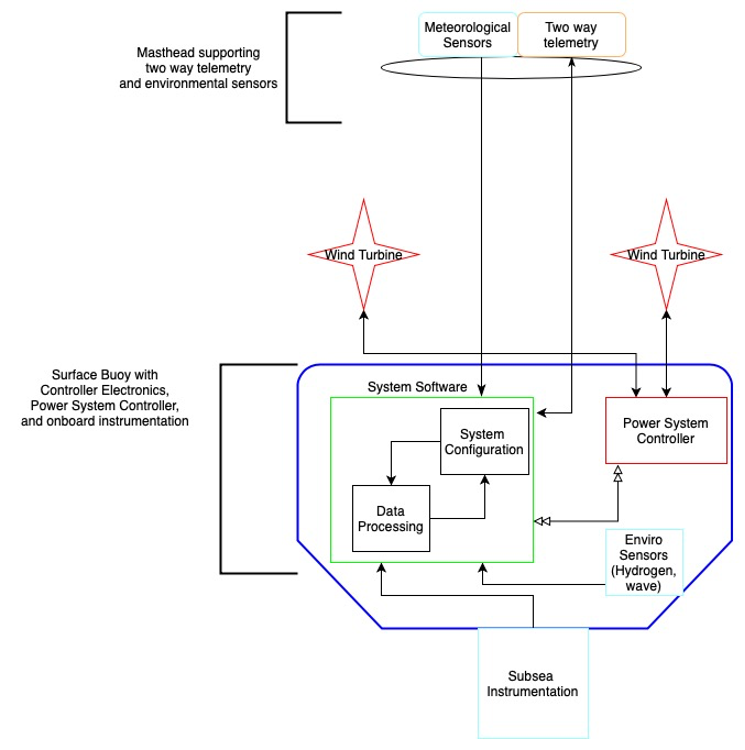 Software flow diagram created by OOI Integration Engineer Alex Franks[/caption]
Software flow diagram created by OOI Integration Engineer Alex Franks[/caption]
The unforgiving environment and long duration deployments of OOI moorings lead to occasional system issues that require intervention. Huge storms, for example, can build waves so high that they threaten wind turbines on the moorings. At the Irminger Sea Array, ice can accumulate so much as to drastically increase the weight of the masthead, and with subsequent buoy motion, risk dunking the masthead and instruments. Other mooring functions require constant attention. The charging system must be monitored to ensure system voltages stay at safe levels and hydrogen generation within the buoy itself is kept within safe limits. Two-way satellite communication allows operators to handle decision making from shore using the most up-to-date information from the buoy.
“Since starting in 2015 and following multiple mooring builds and deployments, I’ve realized that issues can rapidly arise at any time of the day or night. I started thinking about what the buoys can do for themselves, using the data being collected onboard,” Franks said.
One of the game-changing upgrades implemented by Franks was to read environmental data and make automated buoy safety decisions in real-time that were previously performed by the team manually. For example, previously, the team would need to monitor weather forecasts and decide preemptively whether changes to buoy operations were advisable. With recent software changes, the system can now change its configuration based on a variety of sensor inputs. These variables include system voltage, ambient temperature, hydrogen levels inside the buoy well, wind speed, and buoy motion (for sea state approximation). In addition to the software updates, the engineering team redesigned the power system controller. They added charge control circuits and the ability to stop the wind turbines from spinning. The software and electrical upgrades now provide redundant automated safeguards against overcharging situations, hydrogen generation, and turbine damage, maximizing buoy operability in harsh environments.
[caption id="attachment_22946" align="alignleft" width="650"] Onshore engineers are able to keep track of Irminger Sea buoys and instrumentation on this new new dashboard.[/caption]
Onshore engineers are able to keep track of Irminger Sea buoys and instrumentation on this new new dashboard.[/caption]
With a largely independent system, operators also needed a way to easily monitor status of the buoys and instrumentation. The software team created a new shoreside dashboard that allows operators to set up custom alerts and alarms based on variables being collected and telemetered by the buoy. While the buoy systems can now operate autonomously, alerts and alarms maintain a human-in-the-loop component to ensure quality control.
As operations and management of the moorings have progressed, the operations team has found opportunities to fine tune how operators and the system handle edge cases of how the system responds to hardware failures and extreme weather. In the past, sometimes conditions changed faster than the data being transmitted back to shore. This new sophisticated software automates some of the buoy’s responses to changing conditions in real time, which helps to ensure their continued operation even under challenging conditions. The decreased response time to environmental and system events using an automated system, coupled with the ability to monitor and interact remotely, has increased the reliability and survivability of OOI moorings.
Read MoreIrminger Sea Array Overcomes Challenging Conditions to Provide Climate Insights
Deployed 140 miles east of the southern tip of Greenland and three miles south of the Arctic Circle, the Irminger Sea surface mooring floats on a cold empty sea named for a Danish naval admiral few people have heard of, in a location that few people could point to on a North Atlantic chart. The Irminger Sea is delineated less by coastlines or geographic basins and more by what is taking place within the deep ocean here, processes only visible with the aid of deep-sea instruments. To oceanographers and climate scientists the region is a confluence of ocean currents where heat carried from the topics gets extracted and cold water sinks into abyss like few other places worldwide and with climate-changing impacts.
Like most high-latitude oceans, storms are frequent and strong. Some storms migrate northeast from the mid-latitudes. Other storms are born here and then mature to impressively violent conditions influenced by the distant high mountains and massive Greenland icecap. Gale-force winds and steep-faced ocean waves spread east over a wide cone from the tip of Cape Farewell. The ice pack around Greenland ejects icebergs, some washing far out to sea where they threaten vessels. Cold air and sea spray build layers of heavy ice on exposed surfaces and instrument sensors. Other oceans can be found with higher waves, some have colder weather, but in few places do storms intensify so quickly, occur as often, and happen in a place so vital to planetary climate. Right where the storm forces are the strongest is also the perfect place for a tower packed with weather instruments.
The Irminger Sea mooring is designed to collect data in this stormy world where meteorological and ocean measurements, especially at the surface, are rare and hard to sustain. The mooring is recovered and a new one put in its place once a year, typically during the short summer month of July when weather conditions are calmest. At more than 4 meters high, the surface mooring tower is heavily instrumented with meteorological sensors and communication antennas, and the surface float is filled with data loggers and redundant computing elements and controllers that collect, store, and transmit data to shore. In total about four tons of floating equipment is anchored to the bottom by a 1.5-mile cable studded with dozens of instruments sampling the deep interior of this sea. To power everything, the buoy float is packed with rechargeable batteries, fueled by solar panels and wind turbines on the buoy tower. Strong winds are usually welcome because they rapidly re-charge the battery packs. Sometimes, however, these can be too much of a good thing.
[media-caption path="/wp-content/uploads/2021/12/Irminger-storm-waves.png" link="#"]Storm waves captured by the Irminger Sea tower camera #5 on 2019-03-19 at 09:01:00 UTC during a typical bad weather day. Observations made by the WAVSS instrument (from 09:00 to 09:20 UTC) report significant wave heights around 5 m (16 ft) and maximum heights of 21 m (69 ft). Records from a second accelerometer (MOPAK) report a wave ~5 m high passing at 09:01 UTC, possibly the same one in this photo. About half-a minute later, at 09:01:30 UTC, the MOPAK recorded a wave >20 m (no image).[/media-caption]
A recent storm during October 18-19, 2021, was one such time. The mooring was battered by wind speeds exceeding 35 knots (gale force) for almost 24 hours, with some topping out above 50 knots. Heavy storm seas built up and stacked upon themselves for hours. At the storm’s peak, about one third of the highest waves were above 15 m (49 ft). Picture heaving an 8000 lb. surface mooring 80 ft up and down on a tilt-a-whirl ride that never stops. Waves this high can bring tons of water crashing down. Towering waves were recorded, some reaching up to 20-25 m (66-82 ft), so high they approached the limits of our instruments.
The Irminger Sea continues to test our ability to “weather harden” instruments in stormy parts of the world. From November to March, daylight is fleeting, the sun hovers near the horizon and solar panels trickle out only a few milliamps. For the next few months, many of the instruments in the ocean interior and on the tower will continue to sample, each instrument powered by its own small battery. The Irminger surface mooring will communicate once each day, a tiny burst of data with vital signs, until spring returns and the sun revives the cold battery packs.
[media-caption path="/wp-content/uploads/2021/12/Ice-near-mooring-.png" link="#"]Ice near the Irminger Sea mooring 2019-04-02. Credit: @WHOI, Peter Brickley.[/media-caption]
The 2021 storm demonstrated, yet again, the challenges of working in the Irminger Sea. Yet, it also demonstrated the remarkable robustness of the OOI moorings in such extreme conditions. Ocean and meteorological measurements gathered by the Irminger Sea mooring during such storm events are extremely valuable for understanding oceanography and climate processes. Equally important is the invaluable experience gained that will drive continued improvement in the accuracy and durability of instruments deployed under such extreme conditions, with consequent increases in knowledge.
Written by Peter J. Brickley, PhD, Senior Engineer, AOPE Dept., Woods Hole Oceanographic Institution and OOI’s Coastal and Global Scale Nodes Observatory Operations Lead
Read More

